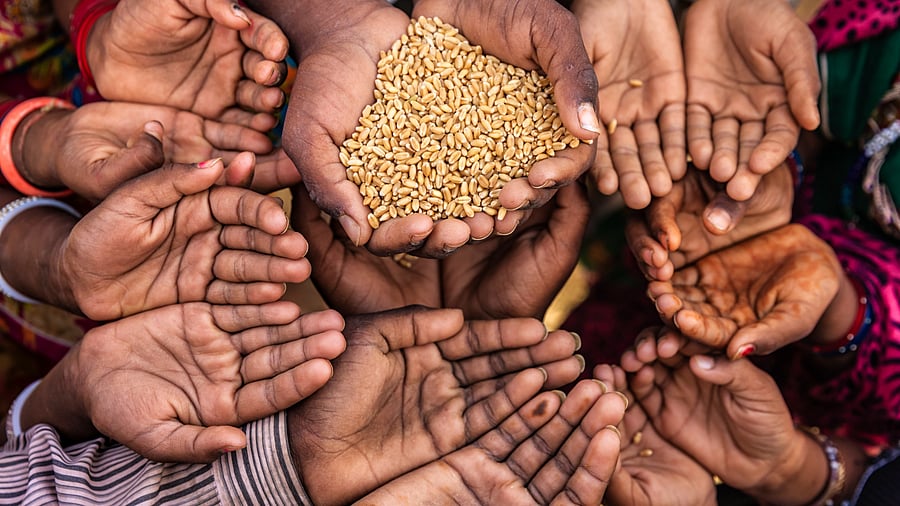
Image for representational purposes.
Credit: iStock Photo
The Global Hunger Index report, which ranks the ten hungriest countries in the world, categorises India under the ‘serious concern’ category. This is deeply troubling. While India is making significant strides in building mega infrastructure projects such as airports, highways, and renewable energy installations, a key point to bear in mind is that all of these projects are land-intensive and are pushing local communities away from their land and livelihoods.
Access to land is crucial in addressing hunger. With the impacts of climate change already making life difficult for many, traditional knowledge and livelihoods are under threat. Across the country, land tenure is about more than cultivation. A range of agro-pastoral livelihoods has coexisted for thousands of years, and this diversity is what helps communities tide over difficult years, even in the face of failed monsoons.
For many, the promise of irrigation to some of the most fertile lands remains a distant dream. Instead, they are coerced into parting with their land for various developmental projects, with little agency to negotiate. Once people are stripped of their land, their ability to deal with the risks of climate events is low, and they become highly vulnerable. Secure access to land enables households to grow food, fodder, and cash crops and to diversify their production based on local conditions. Land ownership also ensures access to loans.
With increasing pressure to divert land to various mega-infrastructure projects—including utility-scale solar parks being established in the name of climate change—a large section of the most vulnerable is left without any means to fend for themselves. Their skills in growing food, rearing animals, and weaving baskets, blankets and cloth, as well as other handmade arts and crafts, have limited scope for making a living in the absence of land, including access to the commons.
Loss of land results in migration, back-breaking construction, and other low-paid, far from dignified, informal jobs. Girl children are often pulled out of school. Child marriage, early childbearing, and lack of access to food are the beginning of the stories of increasing numbers of maternal mortality, infant mortality, and stunted and wasted children in many parts of the country.
Karnataka has been the leader in solar energy with an installed capacity of nearly 10,000 MW. Pavagada, Chamarajnagar, and Koppal are demonstrating large-scale solar energy production. One needs to remember that these are also some of the most backward areas. And the diversion of land comes at a considerable cost to local communities, who receive little in return. A top-down model, implemented through a parastatal that the state is proud of, is slowly pushing people off their land and livelihood.
According to the National family Health Survey (NFHS), a large percentage of children in the state are stunted (35.4%), wasted (19.5%), and underweight (32.5%). Income loss due to joblessness has pushed families to the brink of starvation. There are many challenges to schemes reaching the most needy.
This November, as world leaders have assembled at the 30th meeting of the Conference of the Parties (COP 30) in Belum, Brazil, to discuss climate commitments, focus on finance, and implementation, Karnataka needs to reimagine its climate allegiance and revise its land diversion models if it is to ensure its people do not go to bed hungry. With its 6,000-odd panchayats and non-conventional energy being a function of the Panchayat as per the 73rd Constitutional Amendment, a local, cooperative, community-owned model that ensures energy, livelihood, food, and water security could be the way.
If each of these panchayats were to plan in consultation with their communities, comprehensive, energy-livelihood-food and water-secure panchayats, it could shift the narrative. If every gram panchayat initiates a cooperative-owned solar park, with local women and men as shareholders, the state would be a true leader in reimagining its rural development. This certainly has to be accompanied by rooftop solar mandated in urban centres.
Ensuring that women and youth are central to the cooperative, combined with capacity building and protection of the rural commons, would go a long way not only for food security but also for achieving multiple gains. With its strong solar baseline, as Karnataka just celebrated its 70th Rajyotsava this month, it is well-positioned to reimagine its commitments to address climate targets and secure an equitable, resilient, and nourished Karnataka. The state has long been regarded as a pioneer in strengthening Panchayat Raj Institutions with early devolution of functions and funds. Over the years, there’s been some uneven genuine autonomy in planning and managing natural resources. However, with the climate clock ticking, Karnataka must link its climate commitments to land tenure security and
food security. It’s truly time for Panchayats to lead.
(The writer is an independent researcher)
Disclaimer: The views expressed above are the author's own. They do not necessarily reflect the views of DH.